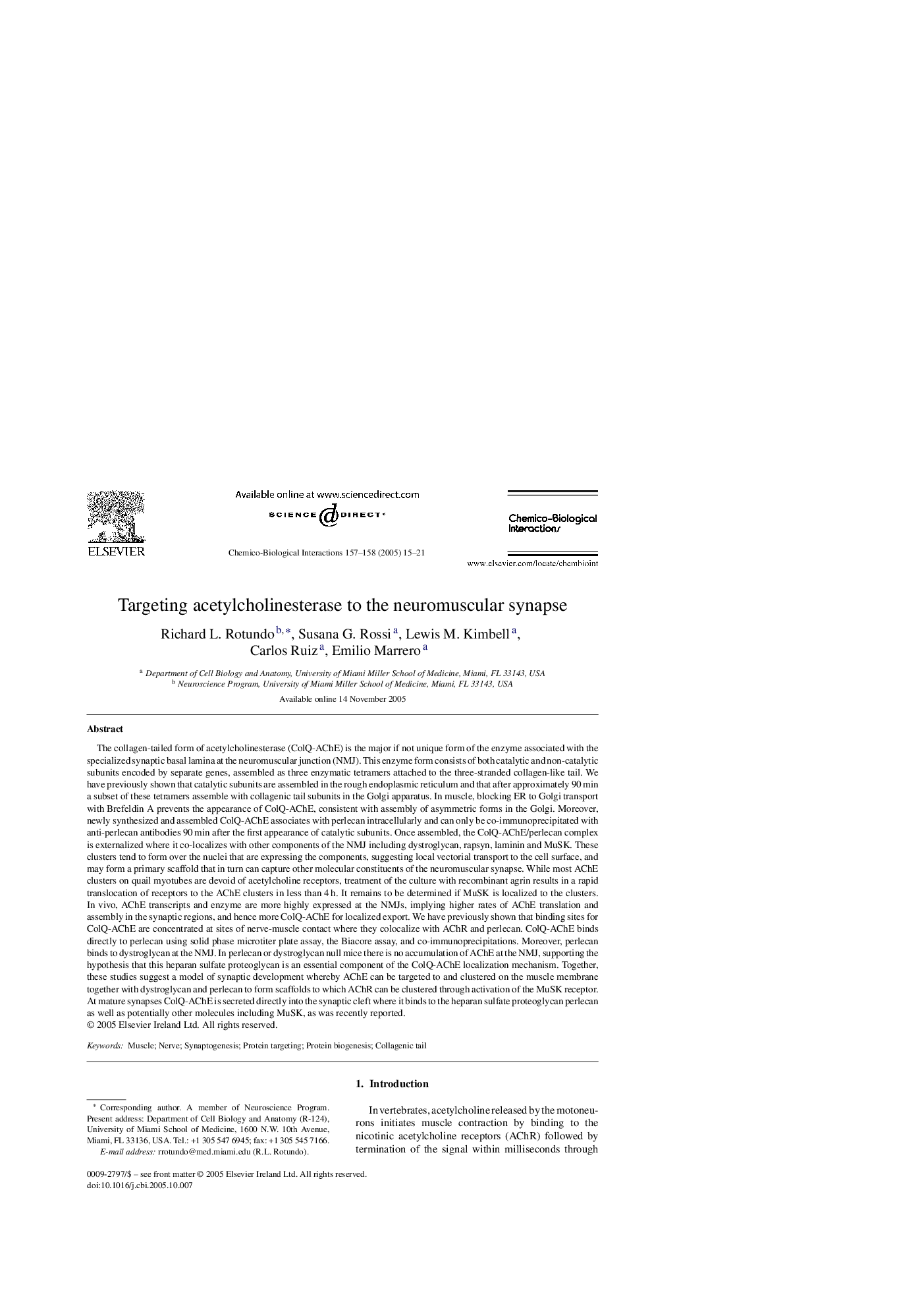| کد مقاله | کد نشریه | سال انتشار | مقاله انگلیسی | نسخه تمام متن |
|---|---|---|---|---|
| 9028054 | 1561659 | 2005 | 7 صفحه PDF | دانلود رایگان |
عنوان انگلیسی مقاله ISI
Targeting acetylcholinesterase to the neuromuscular synapse
دانلود مقاله + سفارش ترجمه
دانلود مقاله ISI انگلیسی
رایگان برای ایرانیان
کلمات کلیدی
موضوعات مرتبط
علوم زیستی و بیوفناوری
علوم محیط زیست
بهداشت، سم شناسی و جهش زایی
پیش نمایش صفحه اول مقاله

چکیده انگلیسی
The collagen-tailed form of acetylcholinesterase (ColQ-AChE) is the major if not unique form of the enzyme associated with the specialized synaptic basal lamina at the neuromuscular junction (NMJ). This enzyme form consists of both catalytic and non-catalytic subunits encoded by separate genes, assembled as three enzymatic tetramers attached to the three-stranded collagen-like tail. We have previously shown that catalytic subunits are assembled in the rough endoplasmic reticulum and that after approximately 90Â min a subset of these tetramers assemble with collagenic tail subunits in the Golgi apparatus. In muscle, blocking ER to Golgi transport with Brefeldin A prevents the appearance of ColQ-AChE, consistent with assembly of asymmetric forms in the Golgi. Moreover, newly synthesized and assembled ColQ-AChE associates with perlecan intracellularly and can only be co-immunoprecipitated with anti-perlecan antibodies 90Â min after the first appearance of catalytic subunits. Once assembled, the ColQ-AChE/perlecan complex is externalized where it co-localizes with other components of the NMJ including dystroglycan, rapsyn, laminin and MuSK. These clusters tend to form over the nuclei that are expressing the components, suggesting local vectorial transport to the cell surface, and may form a primary scaffold that in turn can capture other molecular constituents of the neuromuscular synapse. While most AChE clusters on quail myotubes are devoid of acetylcholine receptors, treatment of the culture with recombinant agrin results in a rapid translocation of receptors to the AChE clusters in less than 4Â h. It remains to be determined if MuSK is localized to the clusters. In vivo, AChE transcripts and enzyme are more highly expressed at the NMJs, implying higher rates of AChE translation and assembly in the synaptic regions, and hence more ColQ-AChE for localized export. We have previously shown that binding sites for ColQ-AChE are concentrated at sites of nerve-muscle contact where they colocalize with AChR and perlecan. ColQ-AChE binds directly to perlecan using solid phase microtiter plate assay, the Biacore assay, and co-immunoprecipitations. Moreover, perlecan binds to dystroglycan at the NMJ. In perlecan or dystroglycan null mice there is no accumulation of AChE at the NMJ, supporting the hypothesis that this heparan sulfate proteoglycan is an essential component of the ColQ-AChE localization mechanism. Together, these studies suggest a model of synaptic development whereby AChE can be targeted to and clustered on the muscle membrane together with dystroglycan and perlecan to form scaffolds to which AChR can be clustered through activation of the MuSK receptor. At mature synapses ColQ-AChE is secreted directly into the synaptic cleft where it binds to the heparan sulfate proteoglycan perlecan as well as potentially other molecules including MuSK, as was recently reported.
ناشر
Database: Elsevier - ScienceDirect (ساینس دایرکت)
Journal: Chemico-Biological Interactions - Volumes 157â158, 15 December 2005, Pages 15-21
Journal: Chemico-Biological Interactions - Volumes 157â158, 15 December 2005, Pages 15-21
نویسندگان
Richard L. Rotundo, Susana G. Rossi, Lewis M. Kimbell, Carlos Ruiz, Emilio Marrero,